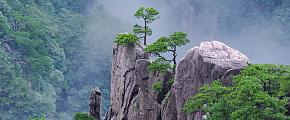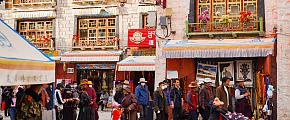3 Famous Ancient Cities & Counties of China
China has many famous ancient cities and counties with diverse features, the three below are very worthwhile recommendations for your exploration. To know more about the local culture, customs, and architecture of these places is indispensable if you are planning your Chinese itinerary.
The Ancient City of Ping Yao - Old Business Centre
Pingyao, an ancient city with a history of over 2,700 years is located in the middle of Shanxi Province, 90km from Taiyuan City, the provincial capital. The original city had a puddle wall when it was first built in 827-782 BC, militarily guarded by general Yin Ji-fu, West Zhou Dynasty. Since 221 BC, the city has been the county seat at all times. Also for military defense, this city was expanded on its original base in 1370 of the Ming Dynasty. Despite so many events or incidents, it survived practically as it was in the 600 years or more since Ming and Qing Dynasties, and ranks as the only intact ancient city of the Ming and Qing Dynasties well Preserved in China.
So far this city has kept well in the ancient city walls, streets, quadrangles, stores, exchange shops, draft banks, escort agencies and temples and so forth. They are all under government protection now. And the original layout, style and features of these architectures have not been changed. They provide us with some living examples for studying the historical development of Chinese politics, economy, culture, military affairs, architecture and art.
In December 1997, the Ancient City of Ping Yao was inscribed on the "World Heritage List" by UNESCO with their consideration that " The Ancient City of Ping Yao is an outstanding example of a Han Chinese city of the Ming and Qing Dynasties ( 14th- 20th centuries) that has retained all its features to an exceptional degree and in doing so provides a remarkably complete picture of cultural, social, economic, and religious development during one of the most seminal periods of Chinese history."
Ancient Shopping Street
It refers to the city's Ming and Qing Street, the center and essence of the city, as well as the cradle of Shanxi merchants. In the old days, along the 450-meter-long street were crowed 78 shops or firms, mostly nationally well-known draft banks and dealers of many generations. Nowadays, they are mainly engaged in antiques, inns or restaurants.
For several centuries, the street has witnessed almost all businesses: draft banks, money shops, pawnshops, Chinese medicine dealers, silk sellers, groceries, and shops of fans, lanterns, or opera costumes. It was so commercially vigorous that it was reputed as "a miniature Beijing". Its brilliance is visible even today: lining up one after another are old trademarks with the charm of the Ming and Qing Dynasties.
Reputed Draft Banks
As the cradle of draft banks of Shanxi Province, Pingyao had the most of them in number and the longest in running. They played an important role in the financial development of China. Among, the most famous are the Rishengchang Draft Bank and Baichuantong Bank. The former is the father of Chinese banks.
Its headquarters are still kept intact at the south of West Street, which architectural layout is compact and considerate, typical of the folding house in central Shanxi Province, and the best preserved in the region as well. Now it is the museum of draft banks, furnished as it was in those days to provide a true to life material evidence of the Shanxi banks in Pingyao. Unlike the Rishengchang Draft Bank, the layout of the latter, Baichuangtong Bank is sole and luxurious. It is much concerned with decoration, typical of the buildings towards the end of the Qing Dynasty which were finely painted and carved with exquisite workmanship, together with extremely luxurious furniture. The bank is now the Museum of Furniture from the rich in Shanxi Province, and on display are ancient wood furniture, porcelains, antiques, calligraphy and painting, all evidence of the luxurious life of those Shanxi merchants.
The Ancient City of Lijiang - A Forgotten Kingdom
Lijiang, a mystical and idyllic ancient city in the northwest of Yunnan Province, is surrounded by verdant mountains, woven by watercourses and crossed by more than 300 bridges. It is the gateway to the northwest Yunnan region, and the No.214 national highway traverses the city to Tibet in the north or to Dali City in the south, the capital of the autonomous prefecture.
The Ancient City of Lijiang has been famous for its typical architecture with different racial features, peculiar flagstone roads, mystic religion, hieroglyph, scripture, dance and sweet ancient music since it was built during the late years of the Southern Song Dynasty and the early years of Yuan Dynasty, In addition, it also has long been known worldwide for its grandiose snow-capped Jade Dragon Snow Mountains, the steep gorge, the elegant Mt. Laojun, the clean Lugu Lake, and the colorful and various customs of the minorities. The outside world is amazed at its ancient and simple sense of "identity of Heaven and Human" and surprised by the ancestors of the minorities who built a city without a wall on the beautiful paradise of Lijiang at this southwest borderland. In December of 1997, it was registered on the World Heritage List by the World Heritage Committee of UNESCO, and this "city forgotten by gods" was unveiled to the world with its oriental mystery and glamour like a bright diamond hidden in the mountains.
Traditions of Naxi Nationality
As one of the 56 nationalities in China, the Naxi nationality is very different from the others. First, in the tradition of the Naxi people, man is considered the sky whereas a woman is a land. The matriarchal clan society of ancient Naxi people lasted for a long time, and the present women of this minority still managed the affairs both inside and outside their home, thus the peculiar custom of this ancient city were women in charge of all while men are idle.
The marital custom of the Naxi people is peculiar. Men and women don't get married. When a girl is about to fall in love with a man, she will make sheep's eyes at the man when appropriate. Then the man is allowed to spend the nights with the girl, but he must take a straw hat, a knife and a rice ball with him when he starts. The rice ball is for distracting the dog from the girl's house, the knife is used to open the bolt of the girl's room, and the straw hat is hung on the door as a mark that the girl is falling in love and cohabiting with a man. Before daybreak, the man must leave the girl's room.
Usually, a Naxi man can cohabit with several women in his life but cannot cohabitate with several women at the same time. And in the Naxi tradition, the grandmother of a family has the last word and uncles are responsible for bringing up of his sisters' children.
Mystic Dongba Culture of Naxi Nationality
Dongba culture is fairly independent and mysterious as compared to those of other minorities in China. It remained unnoticed until some Dongba scriptures were taken to Europe by a French missionary Pere Desgodins and two British in the mid-19th century. Especially, the in1920s, botanist Joseph Rock, an Austro-American came to Lijiang and took a massive volume of Dongba manuscripts back home to sell to the museums. This turned Dongba culture into a hot subject of study in the west. Nowadays an increasing number of western scholars or enthusiasts keep on coming to explore this mystic culture.
I. Dongba Religion
Dongba religion worshipped many gods and believed that everything was animated. In its development, the religion was influenced by Tibetan Bon, Buddhism, and Taoism. It didn't have a unified organization of temples, but an ample stock of written scripture and complicated ceremonies, which exerted manifold effects on the life of the Naxi people.
II.Dongba Scripture
The manuscripts of Dongba scriptures were written in Dongba hieroglyphs. There are so many of them that the exact number is impossible to know. Their content ranges over linguistics, literature, religion, custom, history, art, philosophy, astronomy and calendar, actually an encyclopedia of ancient Naxi people. As part of the ancient civilization of China, Dongba scripture holds great value to study.
III.Dongba Hieroglyph
It was an amazing creation of Naxi ancestors, a hieroglyph born in the 11th century. In this language, the meaning is conveyed by one or more symbols as a sentence, reading from left to right and from the upper to the lower. As an exceptionally precious heritage, it is "the only living hieroglyph still in use in the present world". Now, Donba pictograph is easily seen everywhere in the ancient city, on the shop's trademark or brand, in calligraphy or painting, on crafts or little commodities, and even on tableware.
IV.Naxi Ancient Music
This is classic music wildly popular in Naxi Nationality and extolled as a "living fossil of Chinese music" and the "sound from paradise", one of the oldest survivors in the world. It originated from the music of Taoism about 500-600 years ago. This music has been added to the play techniques of Naxi people, featured in playing all the rarely heard works in Tang (618-907A.D) and Song (960-1279A.D) dynasties, the over-100-year old music instruments which cannot find in elsewhere, and the old players who are about 70-80 in age from all walks of life. Now, this old, elegant, serious, and folk-rooted music has attracted thousands upon thousands of ears to listen to.
Captivating Attractions Nearby
The Ancient City of Lijiang is girdled by a host of attractive and wondrous attractions. After experiencing the city, you should not miss the rewarding explorations below because they offer you the mind-blowing landscapes found in the world.
I. Jade Dragon Snow Mountain
Jade Dragon Snow Mountain is 15km north of Lijiang City, a modern oceanic glacier nearest to the equator in Northern Hemisphere, and a state-level tourist site in China. This mountain has 13 peaks extending for 35km from north to south, alongside the deepest gorge in the world-the Tiger Leaping Gorge. It is snowcapped all year, with grandeur and sublime. Fan Steep, its main peak, is 5,596 meters height above sea-level straight piercing the sky. The mountain is precipitous, picturesque, and peculiar, charming with the scenery sites of Yunshan Spruce Meadow, River of White Water, Ganhaizi Lake, Serac Forest, and so forth, to make the mountain a tourists' resort for sightseeing, exploration, scientific survey, or just vacation enjoyment.
II.the First Bend of the Yangtze River
This famous bend formed in Shigu (Stone Drum) Township of Lijiang City when the longest river in China, the Yangtze River flows by and makes a sharp turn. Standing near this bend, you can see the green hills, high mountains, and beautiful terraced rice fields.
III.Tiger Leaping Gorge
Tiger Leaping Gorge is the deepest gorge of the world formed for the Jade Dragon Snow Mountain and Haba Snow Mountain are cut by Jinsha River. It is 18km north of Lijiang City, between peaks of over 3,000m above the river, which is 80m or more at the widest, or only about 30m at the narrowest, a most dangerous section of Yangtze River about 17km long. At the entrance right in the middle of the river has a lying huge rock, and the rushing water has to squeeze through a 13m passage at both sides. Legend says that tigers often leap to the other side of the river by this rock, thus the gorge earns this name. A more recent discovery is the ancient rock paintings on cliffs of the gorge, which add wonders to the grand gorge of the world.
IV.Mt. Laojun
At the east side of Mt. Laojun, there is the topography of red sandstone of over 200k? is found. The charm is that the sun seems also fond of the beautiful scenery and reluctant to go, and therefore it seems to rise and set for three mimes here each day, an amazing wonder pleasantly termed as Scenery Dawning.
In this tourist site, the Ninety-nine Dragon Ponds, the god of Supreme Laojun, and the topography of red sandstone are regarded as the top three treasures. In addition, there are plenty more other interesting places like Mt. Jinsichang, South Heaven Gate, Azalea Bush, Yellow Dragon Pool, Meile Peach Garden, Mountain of Five Immortals, Buddha Rock in Morning Sunshine, Mountain of Bird King, Ninety-nine Dragon Ponds, Black Dragon Pool, Sishiluo, and Anqilin.
V.Baisha Old Murals
Baisha Township (8km from Lijang) are preserved quite some ancient buildings, and the famous Baisha murals are stored in these buildings such as Glaze Hall, Dabaoji Place, and Dading Pavalion etc. The themes of the murals are mainly religion. They were drawn in about 600 years ago, very characteristic of the painting in Tang and Song Dynasties and those of Naxi, Tibetan, and Bai minorities.
Famous Cultural County - She County
A famous Historical & cultural county of Anhui Province nestles at the foot of the Mt. Huangshan. It is very near the Huangshan Airport and the Huangshan beauty spot, 419km away from Shanghai. During over 1,300-year history, this ancient county has developed its resplendent civilization. Its architecture, medicine, philosophy (named Xin'an Philosophy, it is one of the Confucian schools of idealist philosophy; Confucius is a great thinker in ancient China), drama, painting, carvings, seal cutting, ink, ink stone, food, miniature landscape… are famous in China. Now, these things have been studied as an ancient and living subject by scholars from home and abroad.
Ancient Buildings
She County permeates through the old and simple atmosphere with the ancient bridges, towers, streets, lanes, wells, dams, gardens and workshops. Many charming villages and small towns with water and bridges dotted within this county. Numerous folk houses of several hundred years and lots of ancestral temples appear in many places in the county. When enjoying the beautiful natural landscape and the simple ancient architectures, you will feel that you have stepped into a scenery gallery or a classic architectural art museum.
Home of Monumental Archways
She County is known for "Home of Monumental Archway". In the county, there are over 250 beautiful stone archways which were built in Ming (1368-1627A.D.) and Qing (1616-1909) Dynasties. Among these archways, the complex of Tangyue Archways and the Xuguo Stone Archway are the most famous. Especially, the latter is known as the national treasure of China and the Arc de Triomphe (the Triumphal Arch) of the oriental. Today, these ancient archways have become a tridimensional history book to tell their own stories to visitors each day.
See the TOP10 China Tours or start tailor-making your own with us.
What Our Clients Say
SUBSCRIBE TO WIN A FREE TOUR
Subscribe to our newsletter for a chance to win a free 7-day Peru tour! And more insider travel news, exclusive offers, and inspiration will be sent straight to your inbox.


